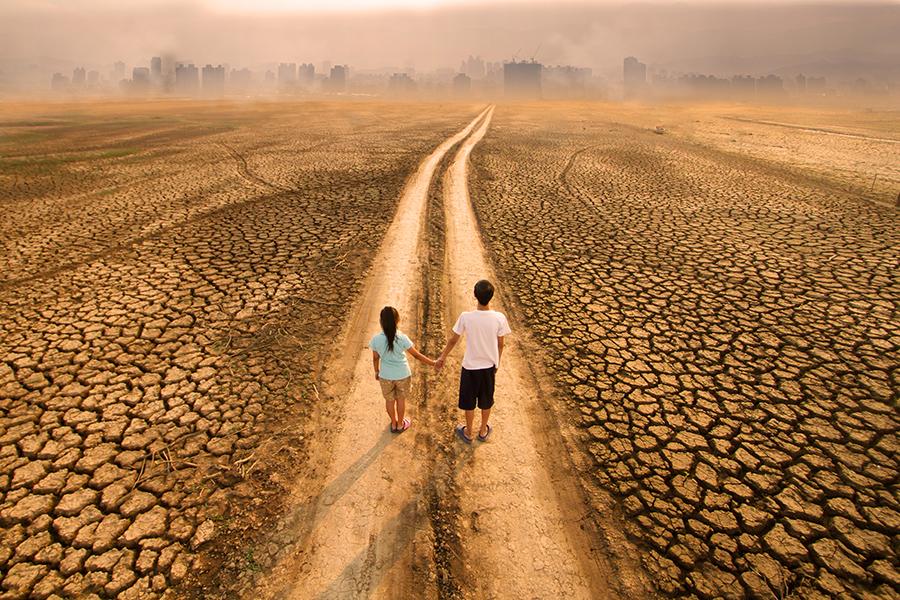Give children a say in the climate change and resilience building conversation
UNICEF's Children's Climate Risk Index reveals that nearly half of the world's children live in countries that are at an 'extremely high risk' from the impacts of climate change. Let them bring a child's perspective—which adults often overlook
India is among the world's most disaster-prone countries. Almost 85 percent of India's area is vulnerable to hazards such as cyclones, earthquakes, landslides, droughts, and so on. As climate change impacts increase unabated, India will witness more such events. These will be further exacerbated by human-induced conflicts and other elements of discrimination such as race and caste, gender, poverty, and disability.
At the recent United Nations Climate Change Conference, more commonly referred to as COP26, a delegation of mothers representing almost 500 parent groups from 44 countries gathered to demand an end to fossil fuel financing. These mothers had seen their children suffer health damage from air pollution. It may have been the biggest such parent mobilisation on any issue in history. This is because climate change is the greatest threat facing the world's children and young people.
UNICEF's Children's Climate Risk Index reveals that nearly half of the world's children live in countries that are at an 'extremely high risk' from the impacts of climate change. Instead of receiving education or enjoying childhood in the safety of their homes, these children are enduring famine, conflict, and deadly diseases due to climate and environmental shocks. These climate change-induced challenges further interact with other social, political and health risks. Overlapping hazards ultimately make certain parts of the world even more precarious places for children—drastically reducing their future potential.
Addressing the climate crisis is a collaborative effort—governments need to work towards conducive environmental policies, businesses must ensure their practices are protective of the natural environment. Schools need to educate with green skills. While this happens, communities need to incorporate solutions to address climate change through resilience.
Community-driven climate resilience planning
It requires communities to be empowered with strategies to actively participate in the development and implementation of protocols and innovations. This will prepare them to survive and thrive through the increasing impacts of climate change. Community resilience needs to ensure equity and the sustainability of resources that are essential to the community, such as food, water, healthcare, education, housing, and economic opportunity. And children and young people need to be recognised and listened to as agents of change in these efforts.
We need to recognise that climate change is the lives of our future generations. Therefore, our children need to be more than just passive victims of disasters. We need to include children, especially deprived, excluded and vulnerable children, into the process of community resilience planning to enable them to develop the capacity to improve their lives and the opportunity to become young adults, parents, and leaders who bring lasting and positive change in their communities in spite and despite climate change.
Child-centric community resilience aims at developing climate change and environmental approaches with and for children. It enables children's participation and reduces their vulnerabilities and deprivations while advancing progress against international commitments, particularly the UN Convention on the Rights of the Child (CRC), the Paris Agreement, the Sendai Framework and the Sustainable Development Goals. These international commitments emphasise the inclusion of children in planning, recognising that they, along with the youth, are agents of change who need to be supported to contribute to disaster risk reduction, according to legislation, national practice, and educational curricula.
Children should also participate in the village disaster management committees (VDMC), a community-level structure that governs disaster management activities before, during, and after a disaster at the community level. They bring children-related issues and also influence government disaster management practices, especially at the local governance level.
Children, along with youth, should be included in the response structures and be trained on specific task force skills that are required during an emergency. As per the National Disaster Management Authority guidelines, it includes: Early warning, search and rescue, first aid, relief and shelter management, and psychosocial tasks. They will be able to perform these roles and responsibilities in pre-disaster, during, and post-disaster by executing mock drills, training and conducting quizzes at community levels.
Schools and other learning centres are the epicentres of children’s social interaction and learning. Therefore, children should be trained in the school safety program to help them make these spaces safe. They should be supported to lead the school risk assessments, planning, and preparation of school safety plans and oversee its implementation with School Management Committees (SMCs) support. For children who are too young and thus most vulnerable to disasters, mothers should lead safety building measures at the ICDS to ensure their ward's safety.
In our work, we have seen first-hand how effective it is to have the children and youth lead the resilience-building processes as they give inputs from a child's perspective—which adults often overlook. This camaraderie helps communities create effective climate change mechanisms that allow them to reimagine an environment fit for a thriving community—with children in the centre where every child deserves a liveable planet.
The author is the country director of ChildFund in India.
The thoughts and opinions shared here are of the author.
Check out our end of season subscription discounts with a Moneycontrol pro subscription absolutely free. Use code EOSO2021. Click here for details.
